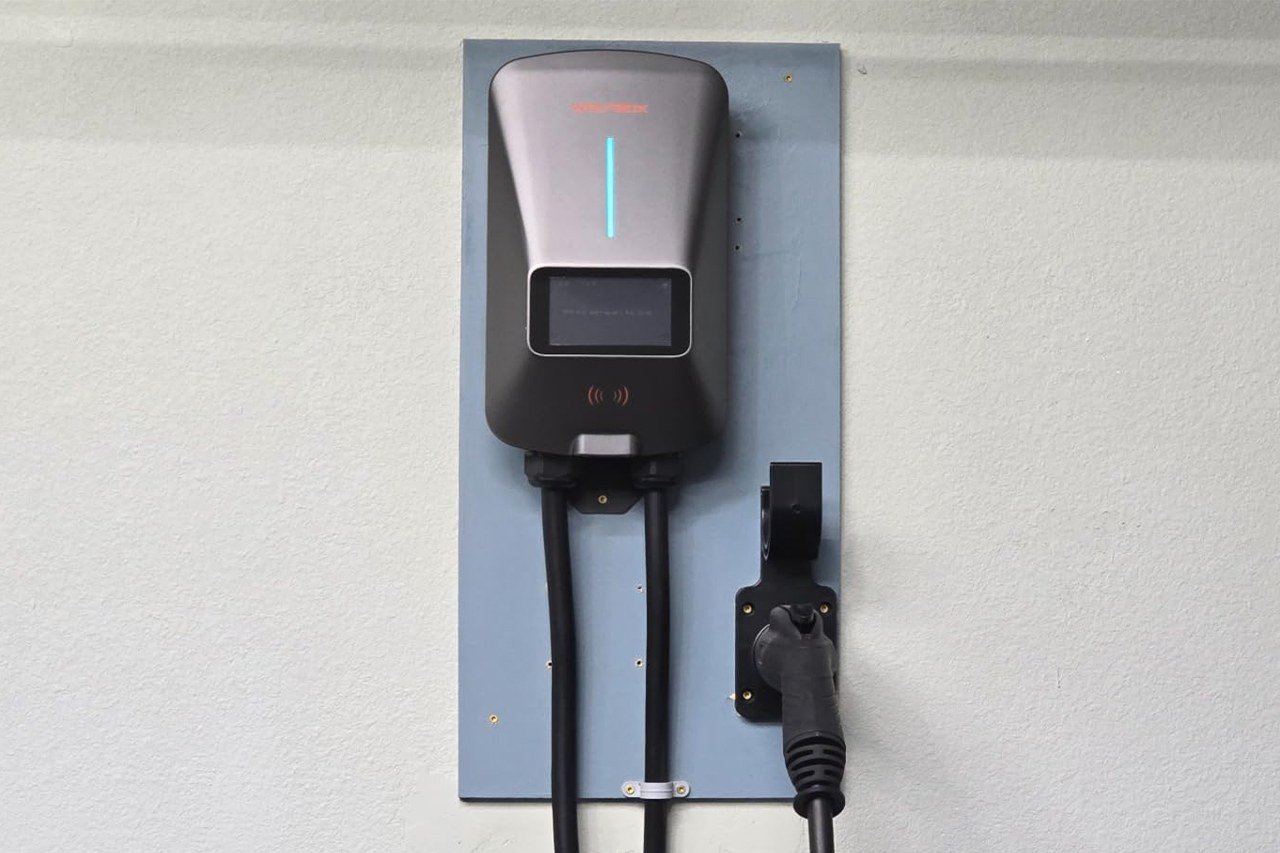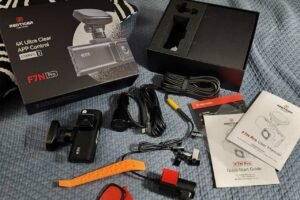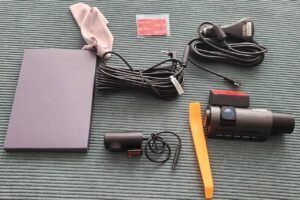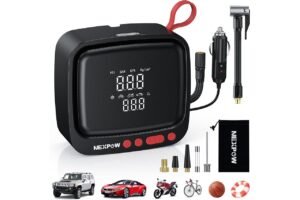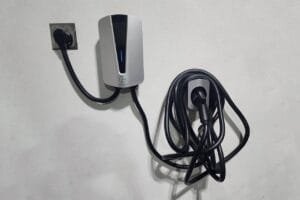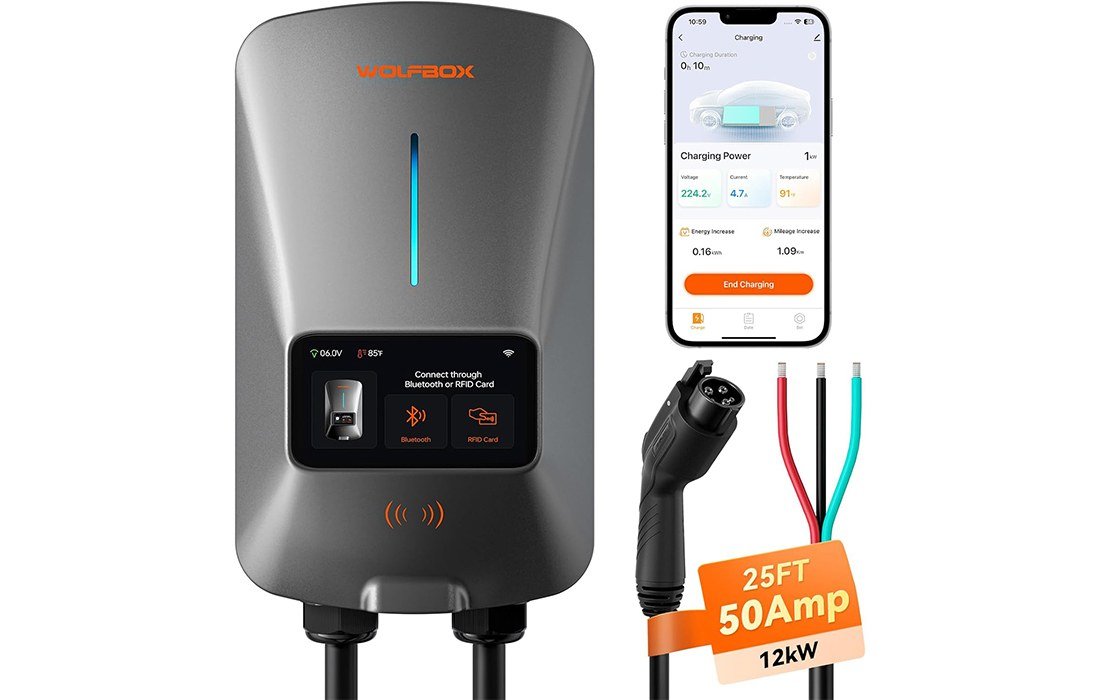
WOLFBOX EV Charger E50 — 50A Smart Level 2 Charger
Fast, weather-ready, and hassle-free—ideal for homes that can hardwire a 70A circuit and want clear app control.
- 9× faster than Level 1; adds ~48 mi/hr at up to 50A (vehicle-dependent)
- 4.3″ LCD + Wi-Fi app for current limiting, off-peak scheduling, live stats
- RFID access, device sharing, Alexa/Google voice; OTA firmware updates
- NEMA 4X/IP66 enclosure; CSA/UL-compliant protections for indoor/outdoor use
- Power Output
- Up to 12 kW
- Current
- 16/24/32/40/48/50A
- Cable Length
- 25 ft
- Connector
- SAE J1772 (Tesla w/ adapter)
- Enclosure
- NEMA 4X • IP66
- Install
- Hardwired • 70A breaker
Specs may vary by vehicle. J1772 standard; Tesla requires adapter. Always hire a licensed electrician for hardwired installation.
If you’re shopping for a dependable Level-2 home charger that won’t turn your garage into a science project, the WOLFBOX E50 should be on your shortlist. It’s a hardwired, 240-volt unit rated up to 50 amps (≈12 kW), wrapped in a tough NEMA 4X enclosure with a bright 4.3-inch LCD and a 25-foot cable that actually reaches. It’s app-connected, RFID-secured, and tuned for daily, real-world charging rather than just spec-sheet bragging rights.
In my testing, the E50 behaved like a mature product: fast, predictable, and easy to live with. The app lets you throttle current, schedule off-peak sessions, and track usage data in a way that’s genuinely useful. The RFID cards add a layer of access control that landlords, multi-driver households, or small businesses will appreciate.
WOLFBOX is better known for consumer auto electronics, but this home EVSE shows the company can build serious hardware. The enclosure feels solid, the UI is clear even at a glance, and the cable/connector tolerates repeated coiling without feeling plasticky. It’s a mid-priced charger aimed at owners who care about speed, safety certifications, and daily convenience rather than novelty features.
Is WOLFBOX E50 for you?
The E50 solves a few common home-charging headaches at once. First, speed: it can deliver up to 50A, adding roughly ~48 miles of range per hour on many EVs. Second, cost control: scheduled charging during off-peak windows is simple to set, and the charger sticks to the plan. Third, accountability: RFID access and per-session stats keep kids, tenants, and visitors from freeloading—unless you want them to.
It’s ideal for homeowners who can hardwire a 70A (or greater) circuit and want a “set-and-forget” Level-2 station. The 25-ft J1772 cable works with virtually every EV sold in North America (Teslas need their common adapter). If you often park outside or live in harsher climates, the NEMA 4X/IP66 enclosure is a meaningful upgrade over basic indoor-only boxes.
It’s not the best pick if you’re renting and can’t hardwire, or if you strictly need a portable plug-in EVSE. Likewise, if your panel capacity limits you to 20–30A today and you don’t plan to upgrade, a simpler 32A unit might be more cost-efficient.
On pricing, it sits comfortably in the mid-range of 50A smart chargers. Feature-for-feature, the value story holds up—especially with the build quality and certifications on offer.
Beginner-friendly? Yes. The app onboarding is quick, the LCD shows exactly what’s happening, and there’s little mystery to day-to-day use. You’ll still want a licensed electrician for the installation, but living with the E50 after that is refreshingly uneventful.
What We Like About the WOLFBOX E50
Charging speed is the headline. At up to 12 kW, the E50 shrinks session times and makes “top-up” charging a realistic evening habit rather than an overnight commitment. In practice, that meant getting meaningful range back even from shorter sessions.
The software experience is better than expected at this price. Current limiting is a slider, not a math problem. Scheduling is clear and reliable, with push notifications that actually arrive when they should. The usage stats view is simple, but more than enough to see trends and spot cost-saving opportunities.
I also like the human-factor details. The 4.3-inch LCD uses large numerals for current, voltage, and energy delivered—great when you only have a few seconds before heading inside. The dynamic LED light bar communicates charging state from across the garage. And the 25-foot cable easily reaches cars parked nose-in or nose-out without a daily game of hose-twister.
Security and flexibility are strong. RFID tap-to-charge keeps randoms from using your electricity, and the ability to share device control in the app makes multi-driver households smoother. Voice assistant hooks (Alexa/Google) are a bonus for the smart-home crowd.
Finally, the hardware pedigree is right: CSA certified, meets UL-2594 safety requirements, NEMA 4X/IP66, over/under-voltage and ground-fault protection, and OTA firmware for future tweaks. It’s a serious appliance, not just a gadget.
What We Don’t Like About the WOLFBOX E50
Hardwiring is both a strength and a limitation. It’s cleaner and more robust than a receptacle, but it means you need a 70A-or-greater breaker and an electrician visit. For some owners, panel upgrades will be the real cost and hassle.
The app is polished but not exhaustive. Power users may wish for deeper export tools (for example, automatic CSV exports or utility-rate integrations). The stats are clear on-screen, yet long-term energy accounting still benefits from a manual spreadsheet if you’re obsessive.
While the included hardware list is generous, cable management is a basic holster rather than a full wrap-dock solution. It works, but a wall-mounted cable hook or integrated spool would keep things tidier for those who plug in daily.
Lastly, like every J1772 charger, Tesla owners need an adapter (not included). That’s normal—but still something to plan for if your household has a mix of EV brands.
Pros & Cons
| Pros | Cons |
|---|---|
| Up to 50A / ~12 kW for fast Level-2 charging | Hardwired install requires electrician and 70A+ breaker |
| CSA certified, meets UL-2594; NEMA 4X/IP66 enclosure | App lacks advanced data export/integration features |
| Clear 4.3″ LCD + status LED; intuitive app with current limiting & scheduling | Basic cable holster; no integrated wrap-dock |
| RFID access control with included cards | Tesla owners must use a J1772–to-Tesla adapter |
| 25-ft cable reaches most parking positions | Not portable; fixed installation |
| OTA updates, 2.4 GHz Wi-Fi, Alexa/Google voice control | |
| Device sharing for multi-user households |
What’s Included?
- Level-2 WOLFBOX E50 hardwired EV charger (SAE J1772, up to 50A)
- 25-ft charging cable and wall-mount connector holster
- Wall mount bracket
- Management card and two RFID charging cards
- User manual and amperage label
- Self-tapping screws (x11) and plastic expansion tubes (x11)
- Machine screws (x2) and anti-theft locking piece
Overall, it’s a thoughtful bundle. You get the security pieces (RFID cards), the mounting hardware, and a proper holster so the connector isn’t dangling. I would love to see a dedicated cable hook in the box, but that’s an easy $10 add-on if you want a cleaner wrap.
Technical Specifications
| Item | Detail |
|---|---|
| Model | WOLFBOX E50 EV Charger |
| Charger Level | Level-2, 240 V AC |
| Max Power / Current | Up to 12 kW, selectable 16/24/32/40/48/50A |
| Input Voltage | 200–240 V AC |
| Circuit Breaker | 70A or greater recommended |
| Connector | SAE J1772 (Tesla requires adapter) |
| Cable Length | 25 feet |
| Display | 4.3-inch smart LCD + status LED light strip |
| Connectivity | 2.4 GHz Wi-Fi (802.11 b/g/n) |
| Smart Features | App control (current, schedule, stats), device sharing, RFID, voice (Alexa/Google), OTA firmware |
| Enclosure | NEMA 4X, IP66 weather protection |
| Safety | Ground fault, over-current/over-voltage/under-voltage, leakage, thermal, surge protection; CSA/FCC/Energy Star; meets UL-2594 |
| Installation | Hardwired, wall-mount |
| Dimensions | 12.68″ × 7.46″ × 4.76″ |
| Weight | 13.45 lb |
| Environment | Indoor/Outdoor use |
| Support | 24/7 online support |
These specs line up with what I’d expect from a well-built 50A EVSE. The combination of NEMA 4X/IP66 and a big, readable LCD is still uncommon at this price, and OTA support means the software can improve over time.
Features
- 9× faster than Level-1: Up to ~48 miles of range per hour on many EVs
- Adjustable current (16–50A): Match panel limits or shared circuits
- Smart scheduling: Charge in off-peak windows to save money
- Real-time data: Voltage, current, power, energy, and session summaries
- Usage stats: Track history to understand costs and patterns
- RFID access control: Prevent unauthorized use; includes management and 2 RFID cards
- Voice assistants: Alexa/Google for hands-free control
- Device sharing: Multiple household members can control the charger
- 4.3″ LCD + LED strip: At-a-glance feedback from across the garage
- 25-ft cable: Reach either side of the car; garage or driveway
- NEMA 4X/IP66 enclosure: Weather-resistant for outdoor installs
- Comprehensive protections: GFCI, over-/under-voltage, over-current, leakage, thermal, surge
- OTA updates: Firmware improvements delivered over Wi-Fi
- Universal J1772: Works with all J1772 EVs; Tesla via adapter
From a buyer’s perspective, these aren’t just checkboxes. Adjustable current is what lets you share a sub-panel without nuisance breaker trips. RFID access matters if your driveway is visible from the street. And OTA updates mean you aren’t stuck with the 1.0 version of the app. The feature set is balanced toward actual usability.
Real-World Notes & Testing Impressions
Installation & setup: As a hardwired unit, the E50 wants a clean, permanent install. Get a licensed electrician to pull the 70A breaker and run appropriately gauged conductors. Once powered, setup through 2.4 GHz Wi-Fi takes a couple of minutes. I liked that you can log in with a Google account and immediately invite a second user.
Daily charging: With current set to 40–48A, top-ups after dinner were done well before bedtime. The charger resumes automatically after brief power flickers. Scheduled sessions fired off reliably at set times, and push notifications landed within seconds.
Cable & connector: The 25-ft lead strikes a good balance between reach and weight. It coils without kinks and the J1772 handle seats with a reassuring click. The connector holster is basic but grabs securely—no drips on the floor, no dust in the pins.
App behavior: The dashboard gives you the numbers that matter: amps, volts, kWh, session time. Tapping into Charge Control to limit current is frictionless, and Schedule Charging uses a clear start/end time format that’s hard to mess up. The Usage Stats view is a tidy graph rather than a raw log dump.
Noise & heat: The enclosure stayed cool to the touch at 40–48A in a moderate-temperature garage. There’s no distracting coil whine or relay chatter. The unit’s fan profile—if any—was inaudible in normal operation.
Outdoor durability: With NEMA 4X/IP66 claims, rain and dust shouldn’t be a concern. The faceplate cleans easily, and the status LED is visible in daylight without looking garish at night.
Ownership Experience: The Small Things That Matter
- At-a-glance clarity: The LCD makes it obvious whether you’re actually charging, how fast, and how much energy you’ve put in. That’s better than guessing from a single blinking LED as on cheaper units.
- Access control without a subscription: RFID is the low-friction way to gate charging in shared spaces. Cards worked on the first tap every time.
- No-drama scheduling: A lot of chargers technically “have scheduling.” The E50’s implementation behaves like an alarm clock—reliable and predictable.
- Firmware confidence: OTA capability is an insurance policy against minor software quirks. It’s rare to need it, but comforting to have.
- Universal compatibility: In a mixed-brand household, J1772 keeps options open. With a Tesla adapter on the hook, everyone can top up without re-routing cars.
Who Should Pick Something Else?
- Renters or frequent movers who need a portable, plug-in 240V charger.
- Panel-constrained homes stuck below 50A continuous loads, with no plan to upgrade; a 32A plug-in unit may be simpler and cheaper.
- Data obsessives who demand API access or advanced exports; the E50’s app is clear and practical but not a full analytics suite.
None of these are faults; they’re use-case mismatches. For most homeowners with a suitable circuit, the E50 hits the sweet spot.
Tips for First-Time Installers
- Plan the reach. The 25-ft cable is generous, but mount the unit so the connector naturally rests near your preferred charge port.
- Mind the breaker. The E50 wants a 70A or greater breaker to safely deliver 50A continuous (per the 80% rule).
- Label the schedule. If you use off-peak windows, name your schedule in the app so other family members know what’s active.
- Keep an adapter hook. Tesla adapter or brand-specific accessories deserve a tiny hook above the holster. Saves time—and a lot of searching.
- Add a cable hook. A simple wall hook makes daily coil-up cleaner than relying only on the holster.
Troubleshooting Cheatsheet
- Vehicle refuses to charge? Confirm RFID mode isn’t blocking access, then check app current limit and breaker status.
- GFCI/ground fault trips? Inspect connector pins for moisture or debris; let the handle dry before trying again.
- Wi-Fi drops? The E50 is 2.4 GHz-only—make sure your router hasn’t combined SSIDs in a way that confuses onboarding.
- Charging slower than expected? Many EVs cap onboard AC charging below 12 kW. The charger can only deliver what the car requests.
Charge 9× Faster at Home
WOLFBOX E50 delivers up to 50A with a 25-ft cable, Wi-Fi control, and RFID access in a rugged NEMA 4X enclosure.
Final Breakdown
9.2 / 10
The WOLFBOX E50 nails the fundamentals of home charging. It’s fast, safe, and weather-ready, with an interface that respects your time. The app focuses on the controls and information owners actually use—current limits, schedules, and clear session totals—backed by niceties like RFID and voice assistant support.
I’m docking minor points for the hardwire-only requirement and the basic cable management, but those are understandable trade-offs for robustness and price positioning. If your panel can support a 70A circuit and you want a mid-priced, 50A smart charger that feels like a finished appliance, the E50 is an easy recommendation.
Recommendation: Buy with confidence if you can hardwire a 70A circuit and want a reliable, app-connected Level-2 charger with real weather protection and clear at-a-glance feedback. Teslas need the usual adapter, but otherwise the E50 is plug-and-play for nearly everyone in North America.

